Difference between revisions of "Testing Article1"
| Line 1: | Line 1: | ||
| − | == | + | ==Overview== |
| − | + | On occasion you may need to provide more '''vertical space''' in a '''row''' to space out one '''row''' from its immediate neighbor '''row''' above or below. This may be useful when '''comment boxes''' are inserted into the chart or when it is necessary to call special attention to a '''row '''or several '''rows'''. | |
| − | OnePager | + | When these needs are known prior to creating the first OnePager chart, you have the option in the '''Template''' to set all '''row heights''' before a chart is created. Additionally, once a chart is created, there are controls in the '''Chart Properties''' form for '''globally '''adjusting all '''row heights''' after chart creation. Finally, there are manual '''editing''' techniques available to adjust individual '''row heights''' using your mouse in the '''Chart Editor''', in the convenient '''text column '''right-click '''context menu''', or the '''open space '''right-click''' context menu'''. |
| − | + | Please keep in mind that any increases or decreases in '''row heights''' in the chart impacts the '''height''' of '''swimlanes''' where the '''edited row''' is a member. | |
| − | + | This article covers the '''global''' adjustment of '''row height''' using the controls in the '''Chart Properties''' form. Since the controls in the '''Template Properties''' form are exactly the same as those in the '''Chart Properties''' form, only the controls in the '''Chart Properties''' form are discussed. This article also covers how to adjust individual '''row heights '''using available '''editing techniques''' in the '''Chart Editor'''. | |
| − | + | ==Globally Adjusting All Row Heights in the Chart== | |
| − | + | ||
| − | + | All '''row heights''' can be set or changed by using the '''Automatic: Use row height of''' window in the '''Template''' or in the '''Chart Properties''' form’s '''Page Layout '''tab as shown below for the '''Chart Properties''' form: | |
| − | + | <center>[[File:P70-12_11_1-(1)-07102020.png]]</center> | |
| + | <!--<center>P70-12_11_1-(1)-07102020.png</center>--> | ||
| − | + | Clicking the '''Automatic: Use row height of '''radio button '''ON''' as shown in the illustration above tells OnePager to use the setting in the window for all '''row heights''' in the chart. Additionally, you can change the setting in the window as required. Unchecking the '''Automatic: Use row height of''' radio button '''OFF '''tells OnePager to set the '''row height''' in accordance with the '''Document height '''which is clicked '''ON''' as the alternative option. When the '''Document height''' radio button is clicked '''ON''', OnePager calculates the '''row height '''using the '''Document height''' and the number of '''rows''' as factors. The setting in the '''Automatic: Use row height of '''window and the '''Document height '''dial control are in either '''inches''' or '''centimeters''' depending on the '''Template'''. | |
| − | + | The '''default settings''' for both options are shown in the above illustration. | |
| − | + | Changing the '''row height''' using either option discussed above does not change the '''height''' of task bars or milestone symbols occupying the individual '''rows'''. The option to alter task bar/milestone symbol '''heights''' as a '''percentage of row height''' is discussed in sub-sections below. | |
| − | + | ===Using the Automatic: Use row height of Control to Globally Change All Row Heights - Example=== | |
| − | + | ||
| − | + | Starting this example from the '''default settings '''for '''row height''', we have the chart shown below: | |
| − | <center>[[File:P70- | + | <center>[[File:P70-12_11_1-(2)-07102020.png]]</center> |
| − | <!--<center>P70- | + | <!--<center>P70-12_11_1-(2)-07102020.png</center>--> |
| − | + | Using the '''Page Layout '''tab in the '''Chart Properties''' form and changing the '''Automatic: Use row height of '''window’s setting to '''0.75''', produces a chart that looks like this: | |
| − | + | <center>[[File:P70-12_11_1-(3)-07102020.png]]</center> | |
| + | <!--<center>P70-12_11_1-(3)-07102020.png</center>--> | ||
| − | + | Note that while the '''row height''' is adjusted to a '''greater value''' all other '''format settings '''remain unchanged. The '''document height value''', however, is '''increased''' and displayed in the ''' Page Layout '''tab’s '''Document Setup '''control group''' '''in the '''Document height''' dial window as shown below: | |
| − | <center>[[File:P70- | + | <center>[[File:P70-12_11_1-(4)-07102020.png]]</center> |
| − | <!--<center>P70- | + | <!--<center>P70-12_11_1-(4)-07102020.png</center>--> |
| − | + | ===Using the Document height Control to Globally Change All Row Heights - Example=== | |
| − | + | The '''Document height '''control shown above can also be used to, in effect, change all '''row heights'''. This is done by clicking the '''Document height''' radio button '''ON''' and setting a different '''document height value '''into the dial window. | |
| − | + | ||
| − | + | For this example, if we reset the '''document height value '''from its '''default''' of '''8.6''' to '''10.5''' the resulting chart looks like this: | |
| − | <center>[[File:P70- | + | <center>[[File:P70-12_11_1-(5)-07102020.png]]</center> |
| − | <!--<center>P70- | + | <!--<center>P70-12_11_1-(5)-07102020.png</center>--> |
| − | + | As in the previous example, changing '''Document height value''' makes a corresponding update to the '''Automatic: Use row height of '''window’s '''value''' as shown here: | |
| − | + | <center>[[File:P70-12_11_1-(6)-07102020.png]]</center> | |
| + | <!--<center>P70-12_11_1-(6)-07102020.png</center>--> | ||
| − | + | The two examples provided above do illustrate how the two controls can be used to change '''row heights''' in the chart. However, there are other factors involved when these changes are made and how they '''impact the look of the chart in output media'''. | |
| − | + | For more information on '''Page Layout and Document Fitting''', please see the article at: [[Page Setup, Document Fitting, and Repeating Elements for Version 7.0 (Portal) | Page Setup, Document Fitting, and Repeating Elements (Portal)]] <!--8.6.1.2-70--> | |
| − | == | + | ==Changing Individual Row Heights Using Drag and Drop== |
| − | + | Individual '''Row heights''' can be adjusted in the '''Chart Editor''' by left-clicking in a '''row’s text column cell''' to select the '''row'''. If there are '''multiple text columns''', clicking in any '''text column''' selects the '''row'''. '''Multiple rows '''can be selected either consecutively or in '''different vertical''' '''row '''positions in the chart. | |
| − | + | ===Selecting a Single Row to Adjust Row Height=== | |
| − | + | ||
| + | Selecting a '''single row''' in order to change its '''row height''' requires that a least one '''text column '''be visible in the chart. Further, the '''row selection''' must select the entire '''row '''which includes all '''text columns''' and the '''row itself''' in the '''graph '''as shown below: | ||
| − | <center>[[File:P70- | + | <center>[[File:P70-12_11_1-(7)-07132020.png]]</center> |
| − | <!--<center>P70- | + | <!--<center>P70-12_11_1-(7)-07132020.png</center>--> |
| − | + | Selecting only the '''text column cell''' in the '''row''' does '''NOT''' select the '''row '''and it is not possible to adjust the '''row’s height''' in this case. To change the '''row height''', grab the top '''grab box''', for example, with the mouse left-click button held down so the cursor becomes a '''double-arrow shape'''. Then '''drag the grab box up''' to increase the '''row height''' or down to decrease the '''row height''' as shown below where the '''row height '''is increased: | |
| − | + | <center>[[File:P70-12_11_1-(8)-07132020.png]]</center> | |
| + | <!--<center>P70-12_11_1-(8)-07132020.png</center>--> | ||
| − | ==== | + | ====Selecting a Single Row - Absolute Height Mode==== |
| − | + | Changing the '''row height''' does not change the '''height''' of any task bars/milestone symbols located in the '''row''' if the task bars/milestone symbol’s '''height '''is determined by the '''Absolute height''' radio button setting in the '''Chart Properties '''form’s '''Task Bars''' or '''Milestones''' tab’s '''Task Height''' sub-control group as shown below: | |
| − | <center> | + | <center>[[File:P70-12_11_1-(9-3)-09132020.png]]</center> |
| + | <!--<center>P70-12_11_1-(9-3)-09132020.png</center>--> | ||
| − | + | ====Selecting a Single Row - Percentage of Row Height Mode==== | |
| − | + | ||
| − | + | If, alternatively, the '''Percentage of row height '''radio button is clicked '''ON''', placing task bars/milestone symbol’s '''heights''' in a '''mode relative to row height''', the task bars and milestone symbols in the''' row''' maintain their '''height’s relative to the row height''' as shown in the sequence below: | |
| − | <center>[[File:P70- | + | :1) Change the '''Task Bar Height '''sub-control group’s '''mode''' to '''Percentage of row height''' as shown here: |
| − | <!--<center>P70- | + | |
| + | <center>[[File:P70-12_11_1-(10-2)-09132020.png]]</center> | ||
| + | <!--<center>P70-12_11_1-(10-2)-09132020.png</center>--> | ||
| + | |||
| + | :2) With the change to '''Percentage of row height mode''', the same '''row selection''' and '''drag and drop '''of the same '''grab box upward''' to the same '''new row height''' results in this chart configuration: | ||
| + | |||
| + | <center>[[File:P70-12_11_1-(11-1)-07132020.png]]</center> | ||
| + | <!--<center>P70-12_11_1-(11-1)-07132020.png</center>--> | ||
| + | |||
| + | Releasing the mouse left-click button changes both the '''row height''' and the '''height''' of the task bars/milestone symbols occupying that '''row'''. | ||
| + | |||
| + | ===Selecting Multiple Rows to Adjust Row Height=== | ||
| + | |||
| + | To select '''multiple rows''', hold down the '''CTRL key''' while selecting '''rows'''. The following illustrates how '''multiple rows''' look when selected: | ||
| + | |||
| + | <center>[[File:P70-12_11_1-(12)-07132020.png]]</center> | ||
| + | <!--<center>P70-12_11_1-(12)-07132020.png</center>--> | ||
| + | |||
| + | The illustration above shows three '''rows''' selected with the '''CTL+Left-Click '''method where each selected '''row '''has its own pair of '''grab boxes'''. | ||
| + | |||
| + | ====Selecting Multiple Rows - Absolute Height Mode==== | ||
| + | |||
| + | Once the '''multiple rows '''are selected, all respond to changes in '''row height '''when one pair of '''grab bars''' are adjusted up or down as shown here for a change in '''row height''' in '''Absolute height mode''': | ||
| + | |||
| + | <center>[[File:P70-12_11_1-(13)-07132020.png]]</center> | ||
| + | <!--<center>P70-12_11_1-(13)-07132020.png</center>--> | ||
| + | |||
| + | Releasing the mouse left-click button changes all the '''row heights''' of the selected '''rows'''. | ||
| + | |||
| + | ====Selecting Multiple Rows – Percentage of Row Height Mode==== | ||
| + | |||
| + | If the same '''row height '''change is made in '''Percentage of Row Height mode''' the resulting chart looks like this: | ||
| + | |||
| + | <center>[[File:P70-12_11_1-(14)-07132020.png]]</center> | ||
| + | <!--<center>P70-12_11_1-(14)-07132020.png</center>--> | ||
| + | |||
| + | Releasing the mouse left-click button changes all the '''row heights''' and the '''heights''' of all task bars/milestone symbols occupying the selected '''rows'''. | ||
| + | |||
| + | ==Changing Row Height Using the Text Column Right-Click Context Menu’s Row Height… Command== | ||
| + | |||
| + | '''Context menus''' are available in the '''Chart Editor''' containing sets of commands that perform '''common editing''' functions in the chart. The '''text column '''right-click '''context menu '''contains a '''Row height … '''command that accesses the '''Row height '''form as discussed below. | ||
| + | |||
| + | ===Using the Row Height Form with a Single Row=== | ||
| + | |||
| + | For example, right-clicking in a '''text column cell''' accesses the '''text column cell '''right-click '''context menu''' shown below: | ||
| + | |||
| + | <center>[[File:P70-12_11_1-(15)-07132020.png]]</center> | ||
| + | <!--<center>P70-12_11_1-(15)-07132020.png</center>--> | ||
| + | |||
| + | In this discussion, the focus is on managing '''row height''' and the '''text column '''right-click '''context menu’s''' '''Row height … '''command that, when clicked, accesses the '''Row height''' form shown below that can be used the change the '''height''' of the selected '''row''': | ||
| + | |||
| + | <center>[[File:P70-12_11_1-(16)-07132020.png]]</center> | ||
| + | <!--<center>P70-12_11_1-(16)-07132020.png</center>--> | ||
| + | |||
| + | Once the '''Row height''' form is accessed, use the dial window to change the '''row height''' to the desired value. As with all '''dial value controls''' of this type the '''unit of measure''' (i.e., inches or centimeters) is determined by your choice of '''Template Properties''' form controlling the creation of the chart. | ||
| + | |||
| + | As an example, suppose the '''dial value control''' in the '''Row height '''form is changed from '''.038 '''(the '''default value''') to '''1.0'''. The resulting '''row '''in '''Absolute Height mode''' looks like this after the '''OK''' button on the '''Row height''' form is clicked: | ||
| + | |||
| + | <center>[[File:P70-12_11_1-(17-1)-09132020.png]]</center> | ||
| + | <!--<center>P70-12_11_1-(17-1)-09132020.png</center>--> | ||
| + | |||
| + | If the chart was in '''Percentage of Row Height mode''', the chart looks like this after the change from a '''Row height ''' of '''0.38 '''to '''1.0''' is finished: | ||
| + | |||
| + | <center>[[File:P70-12_11_1-(18-1)-09132020.png]]</center> | ||
| + | <!--<center>P70-12_11_1-(18-1)-09132020.png</center>--> | ||
| + | |||
| + | ===Using the Row Height Form with Multiple Rows=== | ||
| + | |||
| + | The '''Row height''' form can be used when '''multiple rows '''are selected. As an example, if we select the same three '''rows''' by left-clicking in one of their '''text columns '''as done in the previous sub-section and then right-clicking one of the selected''' row’s text column cells '''to access the '''Row height '''form, the chart looks like this after accessing the '''Row height '''form and making the same change to the selected '''row’s heights''': | ||
| + | |||
| + | <center>[[File:P70-12_11_1-(19-1)-09132020.png]]</center> | ||
| + | <!--<center>P70-12_11_1-(19-1)-09132020.png</center>--> | ||
| + | If the same actions were taken when the chart is in '''Percentage of Row Height mode''', the resulting '''row heights '''look the same as shown above but the '''row’s '''task bar '''heights''' are represented at '''80%''' of the '''row height'''. | ||
| + | |||
| + | ===Resetting the Default Row Height for Selected Row or Rows=== | ||
| + | |||
| + | The '''Row height''' form has a '''Use default''' checkbox that can be clicked '''ON''' to restore the selected''' row height''' to the '''default value''' found in the '''Chart Properties '''form’s '''Task Bars''' or '''Milestones '''tab’s '''Task Bar Height''' sub-control group. This is done by accessing the '''Row height''' form for the selected '''row '''or''' rows '''as illustrated previously, checking the '''Use default '''check box '''ON''' as shown below and then clicking the form’s '''OK '''button: | ||
| + | |||
| + | <center>[[File:P70-12_11_1-(20)-07132020.png]]</center> | ||
| + | <!--<center>P70-12_11_1-(20)-07132020.png</center>--> | ||
| + | |||
| + | When the '''Row height''' form’s '''OK '''button is clicked, the selected '''row’s height''' reverts back to the '''default value''' as shown below: | ||
| + | |||
| + | <center>[[File:P70-12_11_1-(21-1)-09132020.png]]</center> | ||
| + | <!--<center>P70-12_11_1-(21-1)-09132020.png</center>--> | ||
| + | |||
| + | The illustration above shows that only the selected '''row''' has its '''row height''' reverted back to the '''default value''' while the remaining unselected '''rows''' are unchanged. The above illustration was made in the chart’s '''Absolute Height mode'''. Corresponding results are obtained when a '''row '''or '''rows''' are reset to their '''default values''' using the '''Row height''' form’s '''Use default''' checkbox in '''Percentage of Row Height mode'''. | ||
| + | |||
| + | ==Changing Row Height Using the Empty Space Right-Click Context Menu Row Height… Command== | ||
| + | |||
| + | The right-click '''context menu''' for '''open space''' shown below also has a '''Row height …''' command: | ||
| + | |||
| + | <center>[[File:P70-12_11-(22)-07132020.png]]</center> | ||
| + | <!--<center>P70-12_11-(22)-07132020.png</center>--> | ||
| + | |||
| + | When a right-click in '''open space''' is performed, by definition, that right-click takes place in a '''row''' thereby focusing the '''row oriented commands''' in the '''open space''' right-click '''context menu '''on that '''row'''. | ||
| + | |||
| + | The '''Row height … '''command shown above operates as described in the previous sub-section. Clicking the '''Row height … '''command accordingly accesses the '''Row height '''form which can be used to adjust the selected '''row’s height value''' or to reset the selected '''row’s height '''to the '''default value'''. Since a right-click in '''open space '''only selects one '''row''', the '''Row height … '''command in the '''open space '''right-click '''context menu''' can only be used on '''one row at a time'''. | ||
==Related Links== | ==Related Links== | ||
| + | |||
| + | [[Manual Editing Task/Milestone Shapes and Text Labels for Version 7.0 (Portal) | Manual Editing Task/Milestone Shapes and Text Labels (Portal)]] <!--9.0.1-70--> | ||
| + | |||
| + | [[Creating and Editing Rows and Swimlanes for Version 7.0 (Portal) | Creating and Editing Rows and Swimlanes (Portal)]] <!--12.0.1-70--> | ||
| + | |||
| + | [[Collecting, Formatting, and Sorting Task/Milestones into Rows for Version 7.0 | Collecting, Formatting, and Sorting Task/Milestones into Rows]] <!--12.01.1-70--> | ||
[[Creating, Formatting, and Sorting Swimlanes Levels for Version 7.0 | Creating, Formatting, and Sorting Swimlanes Levels]] <!--12.02.1-70--> | [[Creating, Formatting, and Sorting Swimlanes Levels for Version 7.0 | Creating, Formatting, and Sorting Swimlanes Levels]] <!--12.02.1-70--> | ||
| Line 95: | Line 199: | ||
[[Editing Text Columns or Swimlane Labels for Version 7.0 | Editing Text Columns or Swimlane Labels]] <!--12.3.1-70--> | [[Editing Text Columns or Swimlane Labels for Version 7.0 | Editing Text Columns or Swimlane Labels]] <!--12.3.1-70--> | ||
| − | |||
| − | |||
[[Editing Row Properties for Version 7.0 | Editing Row Properties]] <!--12.22.1-70--> | [[Editing Row Properties for Version 7.0 | Editing Row Properties]] <!--12.22.1-70--> | ||
| Line 102: | Line 204: | ||
[[Editing Swimlane Properties for Version 7.0 | Editing Swimlane Properties]] <!--12.23.1-70--> | [[Editing Swimlane Properties for Version 7.0 | Editing Swimlane Properties]] <!--12.23.1-70--> | ||
| − | (12. | + | [[Zebra Striping for Rows and Swimlanes for OnePager Pro for Version 7.0 | Zebra Striping for Rows and Swimlanes for OnePager Pro]] <!--12.24.1-70--> |
| + | |||
| + | [[Zebra Striping for Rows and Swimlanes for OnePager Express for Version 7.0 | Zebra Striping for Rows and Swimlanes for OnePager Express]] <!--12.24.2-70--> | ||
| + | |||
| + | [[Editing with the Chart Properties form for Version 7.0 (Portal) | Editing with the Chart Properties form (Portal)]] <!--21.0.1-70--> | ||
| + | |||
| + | [[Managing Templates for Version 7.0 (Portal) | Managing Templates (Portal)]] <!--24.0.1-70--> | ||
| + | |||
| + | (12.11.1-70) | ||
[[Category:Version 7.0]] | [[Category:Version 7.0]] | ||
| Line 111: | Line 221: | ||
[[Category:Rows and Swimlanes]] | [[Category:Rows and Swimlanes]] | ||
[[Category:Multiple Swimlane Levels]] | [[Category:Multiple Swimlane Levels]] | ||
| − | |||
| − | |||
[[Category:Task/Milestone Editing]] | [[Category:Task/Milestone Editing]] | ||
[[Category:Labels]] | [[Category:Labels]] | ||
| + | [[Category:Text Columns]] | ||
[[Category:Mavericks]] | [[Category:Mavericks]] | ||
| + | [[Category:Row Stripes]] | ||
| + | [[Category:Swimlane Stripes]] | ||
[[Category:OnePager Pro]] | [[Category:OnePager Pro]] | ||
[[Category:OnePager Express]] | [[Category:OnePager Express]] | ||
Revision as of 17:57, 14 January 2021
Contents
- 1 Overview
- 2 Globally Adjusting All Row Heights in the Chart
- 3 Changing Individual Row Heights Using Drag and Drop
- 4 Changing Row Height Using the Text Column Right-Click Context Menu’s Row Height… Command
- 5 Changing Row Height Using the Empty Space Right-Click Context Menu Row Height… Command
- 6 Related Links
Overview
On occasion you may need to provide more vertical space in a row to space out one row from its immediate neighbor row above or below. This may be useful when comment boxes are inserted into the chart or when it is necessary to call special attention to a row or several rows.
When these needs are known prior to creating the first OnePager chart, you have the option in the Template to set all row heights before a chart is created. Additionally, once a chart is created, there are controls in the Chart Properties form for globally adjusting all row heights after chart creation. Finally, there are manual editing techniques available to adjust individual row heights using your mouse in the Chart Editor, in the convenient text column right-click context menu, or the open space right-click context menu.
Please keep in mind that any increases or decreases in row heights in the chart impacts the height of swimlanes where the edited row is a member.
This article covers the global adjustment of row height using the controls in the Chart Properties form. Since the controls in the Template Properties form are exactly the same as those in the Chart Properties form, only the controls in the Chart Properties form are discussed. This article also covers how to adjust individual row heights using available editing techniques in the Chart Editor.
Globally Adjusting All Row Heights in the Chart
All row heights can be set or changed by using the Automatic: Use row height of window in the Template or in the Chart Properties form’s Page Layout tab as shown below for the Chart Properties form:
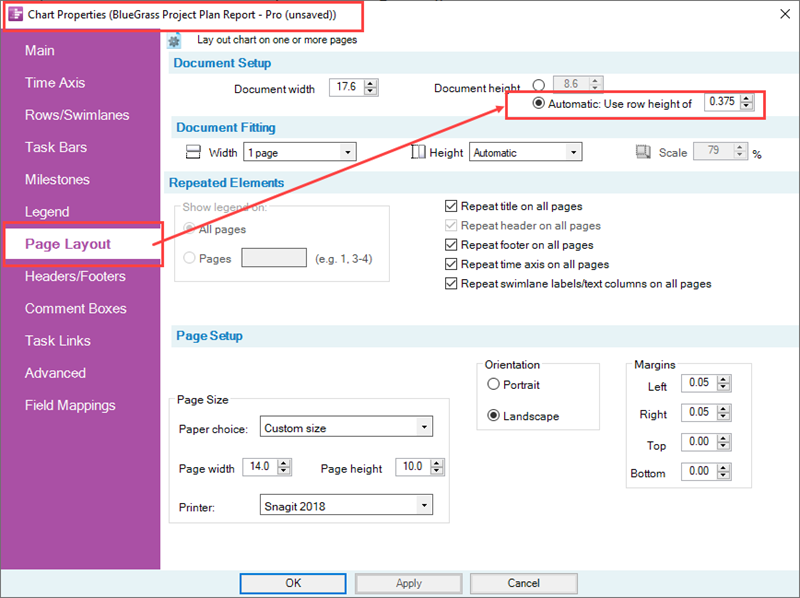
Clicking the Automatic: Use row height of radio button ON as shown in the illustration above tells OnePager to use the setting in the window for all row heights in the chart. Additionally, you can change the setting in the window as required. Unchecking the Automatic: Use row height of radio button OFF tells OnePager to set the row height in accordance with the Document height which is clicked ON as the alternative option. When the Document height radio button is clicked ON, OnePager calculates the row height using the Document height and the number of rows as factors. The setting in the Automatic: Use row height of window and the Document height dial control are in either inches or centimeters depending on the Template.
The default settings for both options are shown in the above illustration.
Changing the row height using either option discussed above does not change the height of task bars or milestone symbols occupying the individual rows. The option to alter task bar/milestone symbol heights as a percentage of row height is discussed in sub-sections below.
Using the Automatic: Use row height of Control to Globally Change All Row Heights - Example
Starting this example from the default settings for row height, we have the chart shown below:
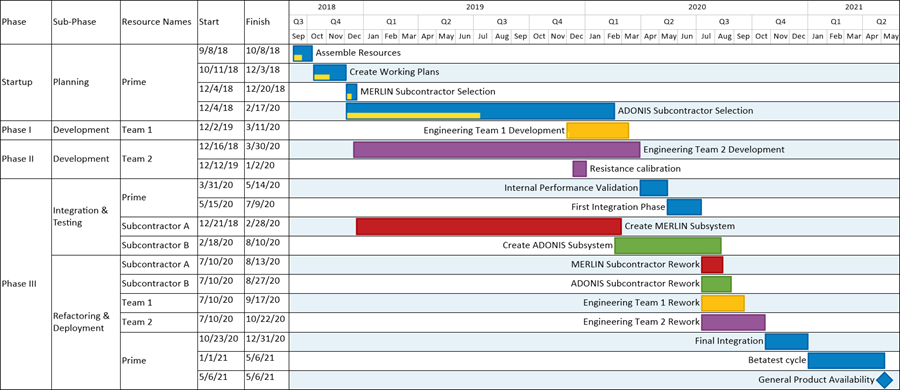
Using the Page Layout tab in the Chart Properties form and changing the Automatic: Use row height of window’s setting to 0.75, produces a chart that looks like this:
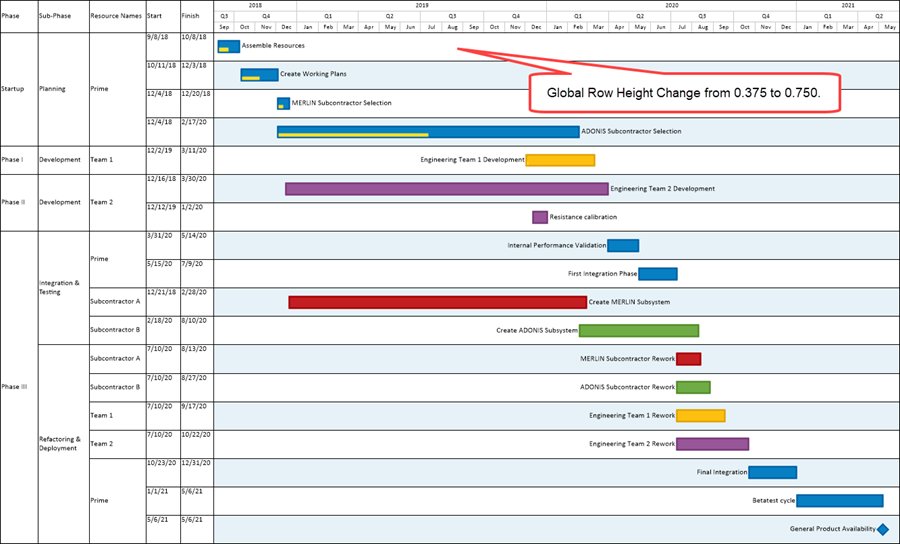
Note that while the row height is adjusted to a greater value all other format settings remain unchanged. The document height value, however, is increased and displayed in the Page Layout tab’s Document Setup control group in the Document height dial window as shown below:
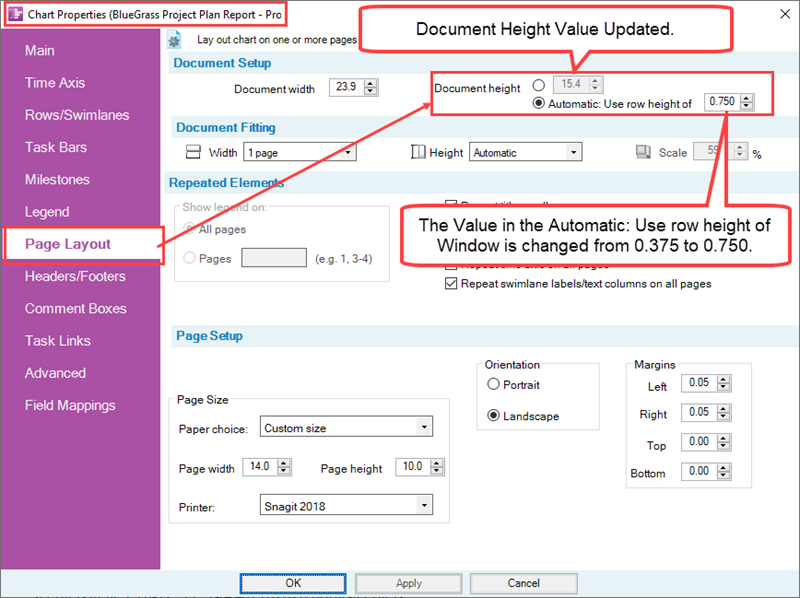
Using the Document height Control to Globally Change All Row Heights - Example
The Document height control shown above can also be used to, in effect, change all row heights. This is done by clicking the Document height radio button ON and setting a different document height value into the dial window.
For this example, if we reset the document height value from its default of 8.6 to 10.5 the resulting chart looks like this:
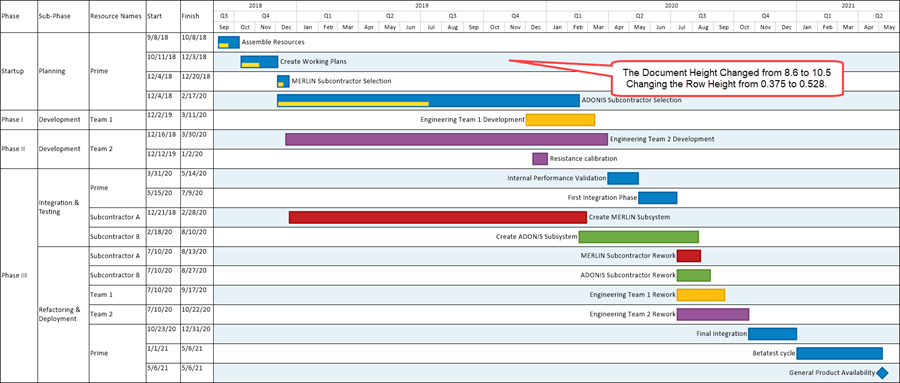
As in the previous example, changing Document height value makes a corresponding update to the Automatic: Use row height of window’s value as shown here:
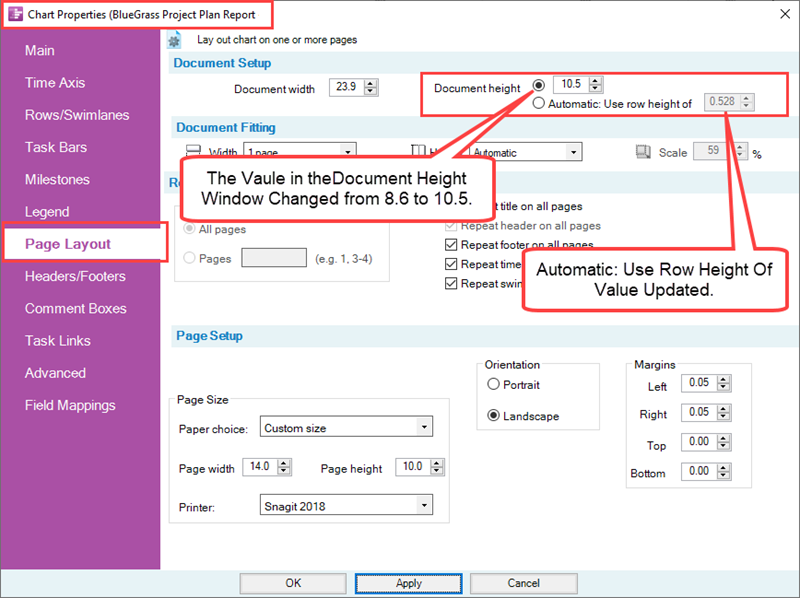
The two examples provided above do illustrate how the two controls can be used to change row heights in the chart. However, there are other factors involved when these changes are made and how they impact the look of the chart in output media.
For more information on Page Layout and Document Fitting, please see the article at: Page Setup, Document Fitting, and Repeating Elements (Portal)
Changing Individual Row Heights Using Drag and Drop
Individual Row heights can be adjusted in the Chart Editor by left-clicking in a row’s text column cell to select the row. If there are multiple text columns, clicking in any text column selects the row. Multiple rows can be selected either consecutively or in different vertical row positions in the chart.
Selecting a Single Row to Adjust Row Height
Selecting a single row in order to change its row height requires that a least one text column be visible in the chart. Further, the row selection must select the entire row which includes all text columns and the row itself in the graph as shown below:

Selecting only the text column cell in the row does NOT select the row and it is not possible to adjust the row’s height in this case. To change the row height, grab the top grab box, for example, with the mouse left-click button held down so the cursor becomes a double-arrow shape. Then drag the grab box up to increase the row height or down to decrease the row height as shown below where the row height is increased:

Selecting a Single Row - Absolute Height Mode
Changing the row height does not change the height of any task bars/milestone symbols located in the row if the task bars/milestone symbol’s height is determined by the Absolute height radio button setting in the Chart Properties form’s Task Bars or Milestones tab’s Task Height sub-control group as shown below:
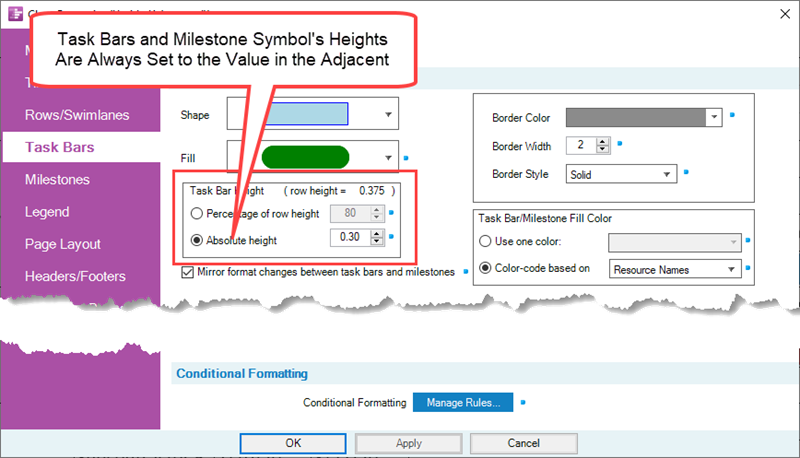
Selecting a Single Row - Percentage of Row Height Mode
If, alternatively, the Percentage of row height radio button is clicked ON, placing task bars/milestone symbol’s heights in a mode relative to row height, the task bars and milestone symbols in the row maintain their height’s relative to the row height as shown in the sequence below:
- 1) Change the Task Bar Height sub-control group’s mode to Percentage of row height as shown here:
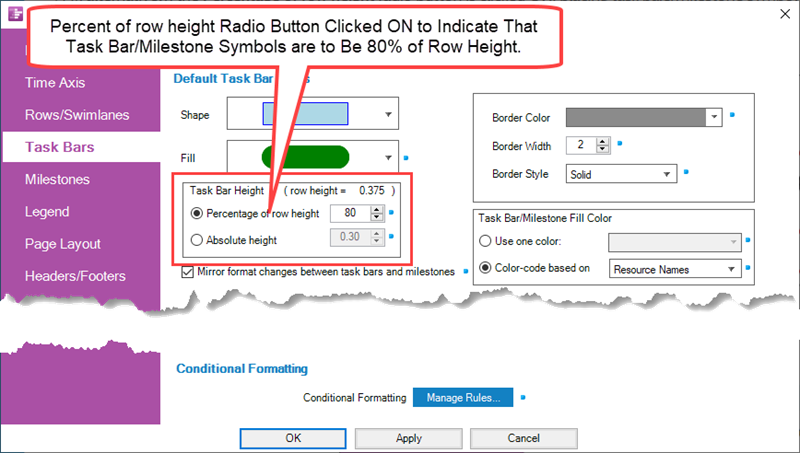
- 2) With the change to Percentage of row height mode, the same row selection and drag and drop of the same grab box upward to the same new row height results in this chart configuration:

Releasing the mouse left-click button changes both the row height and the height of the task bars/milestone symbols occupying that row.
Selecting Multiple Rows to Adjust Row Height
To select multiple rows, hold down the CTRL key while selecting rows. The following illustrates how multiple rows look when selected:

The illustration above shows three rows selected with the CTL+Left-Click method where each selected row has its own pair of grab boxes.
Selecting Multiple Rows - Absolute Height Mode
Once the multiple rows are selected, all respond to changes in row height when one pair of grab bars are adjusted up or down as shown here for a change in row height in Absolute height mode:
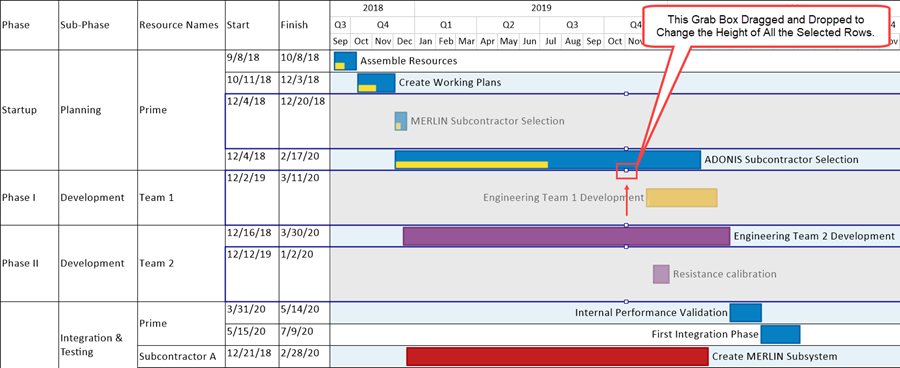
Releasing the mouse left-click button changes all the row heights of the selected rows.
Selecting Multiple Rows – Percentage of Row Height Mode
If the same row height change is made in Percentage of Row Height mode the resulting chart looks like this:
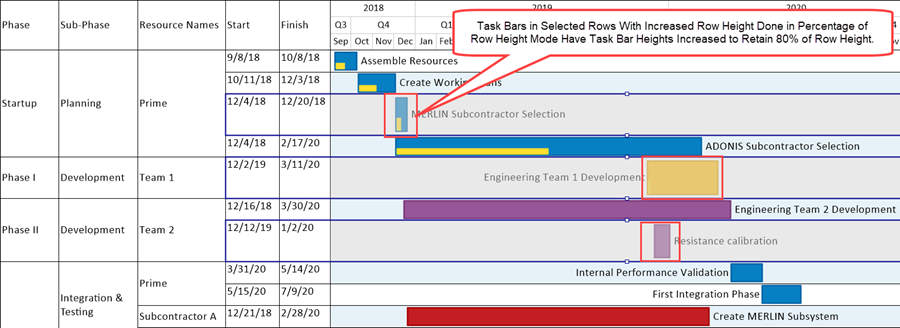
Releasing the mouse left-click button changes all the row heights and the heights of all task bars/milestone symbols occupying the selected rows.
Changing Row Height Using the Text Column Right-Click Context Menu’s Row Height… Command
Context menus are available in the Chart Editor containing sets of commands that perform common editing functions in the chart. The text column right-click context menu contains a Row height … command that accesses the Row height form as discussed below.
Using the Row Height Form with a Single Row
For example, right-clicking in a text column cell accesses the text column cell right-click context menu shown below:

In this discussion, the focus is on managing row height and the text column right-click context menu’s Row height … command that, when clicked, accesses the Row height form shown below that can be used the change the height of the selected row:

Once the Row height form is accessed, use the dial window to change the row height to the desired value. As with all dial value controls of this type the unit of measure (i.e., inches or centimeters) is determined by your choice of Template Properties form controlling the creation of the chart.
As an example, suppose the dial value control in the Row height form is changed from .038 (the default value) to 1.0. The resulting row in Absolute Height mode looks like this after the OK button on the Row height form is clicked:

If the chart was in Percentage of Row Height mode, the chart looks like this after the change from a Row height of 0.38 to 1.0 is finished:

Using the Row Height Form with Multiple Rows
The Row height form can be used when multiple rows are selected. As an example, if we select the same three rows by left-clicking in one of their text columns as done in the previous sub-section and then right-clicking one of the selected row’s text column cells to access the Row height form, the chart looks like this after accessing the Row height form and making the same change to the selected row’s heights:
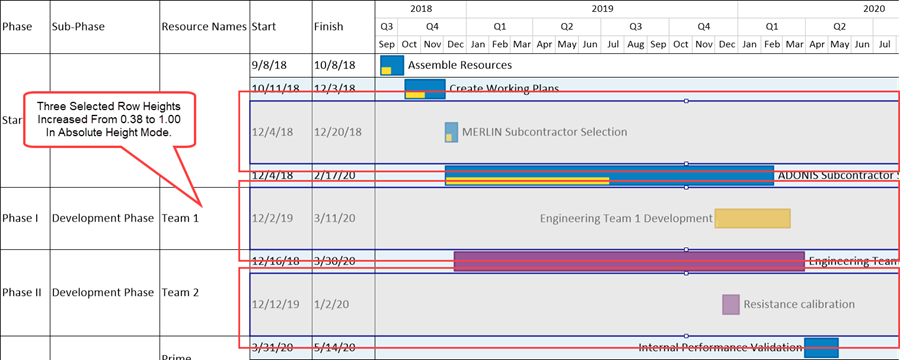
If the same actions were taken when the chart is in Percentage of Row Height mode, the resulting row heights look the same as shown above but the row’s task bar heights are represented at 80% of the row height.
Resetting the Default Row Height for Selected Row or Rows
The Row height form has a Use default checkbox that can be clicked ON to restore the selected row height to the default value found in the Chart Properties form’s Task Bars or Milestones tab’s Task Bar Height sub-control group. This is done by accessing the Row height form for the selected row or rows as illustrated previously, checking the Use default check box ON as shown below and then clicking the form’s OK button:
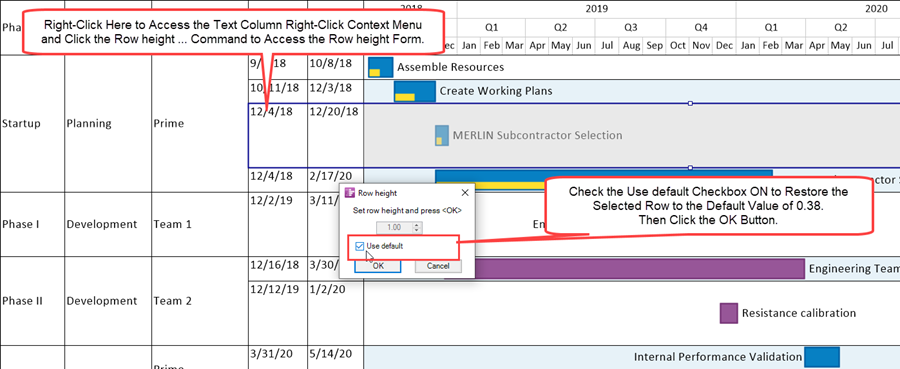
When the Row height form’s OK button is clicked, the selected row’s height reverts back to the default value as shown below:
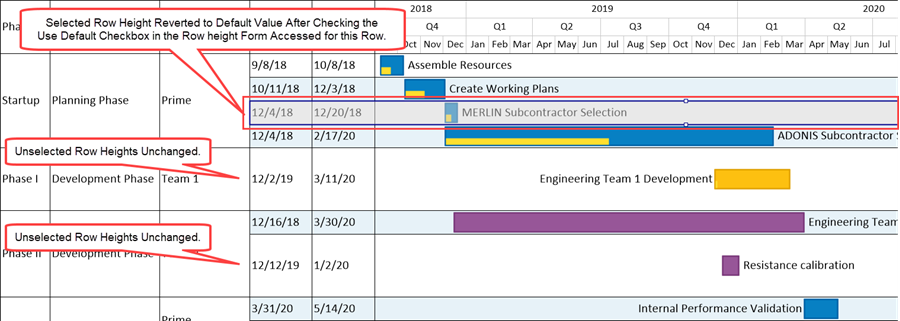
The illustration above shows that only the selected row has its row height reverted back to the default value while the remaining unselected rows are unchanged. The above illustration was made in the chart’s Absolute Height mode. Corresponding results are obtained when a row or rows are reset to their default values using the Row height form’s Use default checkbox in Percentage of Row Height mode.
Changing Row Height Using the Empty Space Right-Click Context Menu Row Height… Command
The right-click context menu for open space shown below also has a Row height … command:
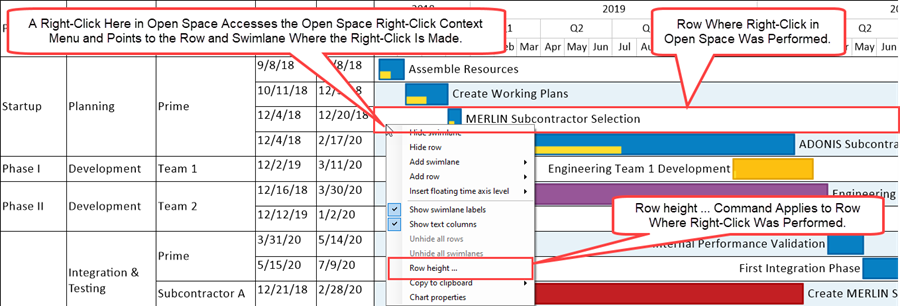
When a right-click in open space is performed, by definition, that right-click takes place in a row thereby focusing the row oriented commands in the open space right-click context menu on that row.
The Row height … command shown above operates as described in the previous sub-section. Clicking the Row height … command accordingly accesses the Row height form which can be used to adjust the selected row’s height value or to reset the selected row’s height to the default value. Since a right-click in open space only selects one row, the Row height … command in the open space right-click context menu can only be used on one row at a time.
Related Links
Manual Editing Task/Milestone Shapes and Text Labels (Portal)
Creating and Editing Rows and Swimlanes (Portal)
Collecting, Formatting, and Sorting Task/Milestones into Rows
Creating, Formatting, and Sorting Swimlanes Levels
Creating and Formatting Text Columns
Editing Text Columns or Swimlane Labels
Zebra Striping for Rows and Swimlanes for OnePager Pro
Zebra Striping for Rows and Swimlanes for OnePager Express
Editing with the Chart Properties form (Portal)
(12.11.1-70)